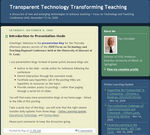FoTT — Plenary Session: Ray Schroeder
Posted by Malcolm Hays
 Ray Schroeder presented at the first of two plenary sessions we attended at the Focus on Teaching and Technology Conference in St. Louis. Dr. Schroeder is currently the Director of Technology Enhanced Learning and an Emeritus professor at University of Illinois at Springfield.
Ray Schroeder presented at the first of two plenary sessions we attended at the Focus on Teaching and Technology Conference in St. Louis. Dr. Schroeder is currently the Director of Technology Enhanced Learning and an Emeritus professor at University of Illinois at Springfield.
The focus of Dr. Schroeder’s presentation was using “transparent” technologies to transform teaching. Dr. Schroeder defines “transparent technology” as those technologies that “do not get in the way of teaching.”
Unlike most of the presenters, Dr. Schroeder used one of his many blogs as his presentation platform: Transparent Technology Transforming Teaching (this was also the title of his presentation). His unique approach has some key advantages over the more “traditional” PowerPoint presentation.
First, all of the content for his presentation is immediately accessible simply by scrolling down the page. You don’t need to scroll through innumerable slides–each of which might have its own unique animation or other content that interferes with your navigation. This makes it very easy to “browse” his presentation, like any other blog out there.
Second, the use of a blog for the presentation allows for a certain degree of feedback from visitors. If a blog is to be used as part of a course (instead of a presentation), the instructor can set up rules for commenting on their blog that allow only registered individuals the ability to comment–this is determined by the blog engine used and by the instructor’s own policies. He (or she) will need to require students to register for the blog so they can post comments. Again, this feature allows visitors to the blog to browse the different entries and provide feedback on particularly interesting ones.
Third, blogs allow for easier hyperlinking than PowerPoint. Because the blog is delivered through a browser, clicking on a link will take you to a new web page without having to open a separate application to do so. “Tabbed” browsing in Mozilla Firefox, Apple Safari or another web browser also allows you to navigate to hyperlinks contained in the blog without ever having to close the blog or navigate away from it. This is definitely superior to PowerPoint navigation of hyperlinks.
Finally, presenting content in a blog means you can arrange your content in sequence chronologically or by category. This means that visitors can access content of a particular interest (e.g. the blog you are reading has a “Blackboard” category because we support a number of Blackboard issues). They can also see content unfolded over time, which may be extremely relevant in time-sensitive courses (e.g. political science, technology development).
Oh, one more thing. Because of the way blogs are built, they can easily contain other Web 2.0 technologies such as YouTube flash videos, quick online surveys, “liveblogging” applications, and much, much more. PowerPoint has none of these features.
One of the downsides to creating a blog for presentations is the fact that as an instructor, you will need to take the time to sit down and figure out how your presentation of content will be structured to take into account the many new ways in which a blog can be used to deliver content. Blogs are extremely flexible, however, and very easy to set up. Dr. Schroeder’s blog for his presentation was created using Blogspot (powered by Blogger). It is a very simple blog, but still contains a wide variety of different content. If Dr. Schroeder was so inclined, he could add some customized features to his blog to make it more his own or he could move his blog to a different blog engine (e.g. Movable Type).
Dr. Schroeder’s presentation was a very different experience than most presentations I’ve sat through and gave me quite a bit to think about with regard to developing my own pedagogical style of instruction.